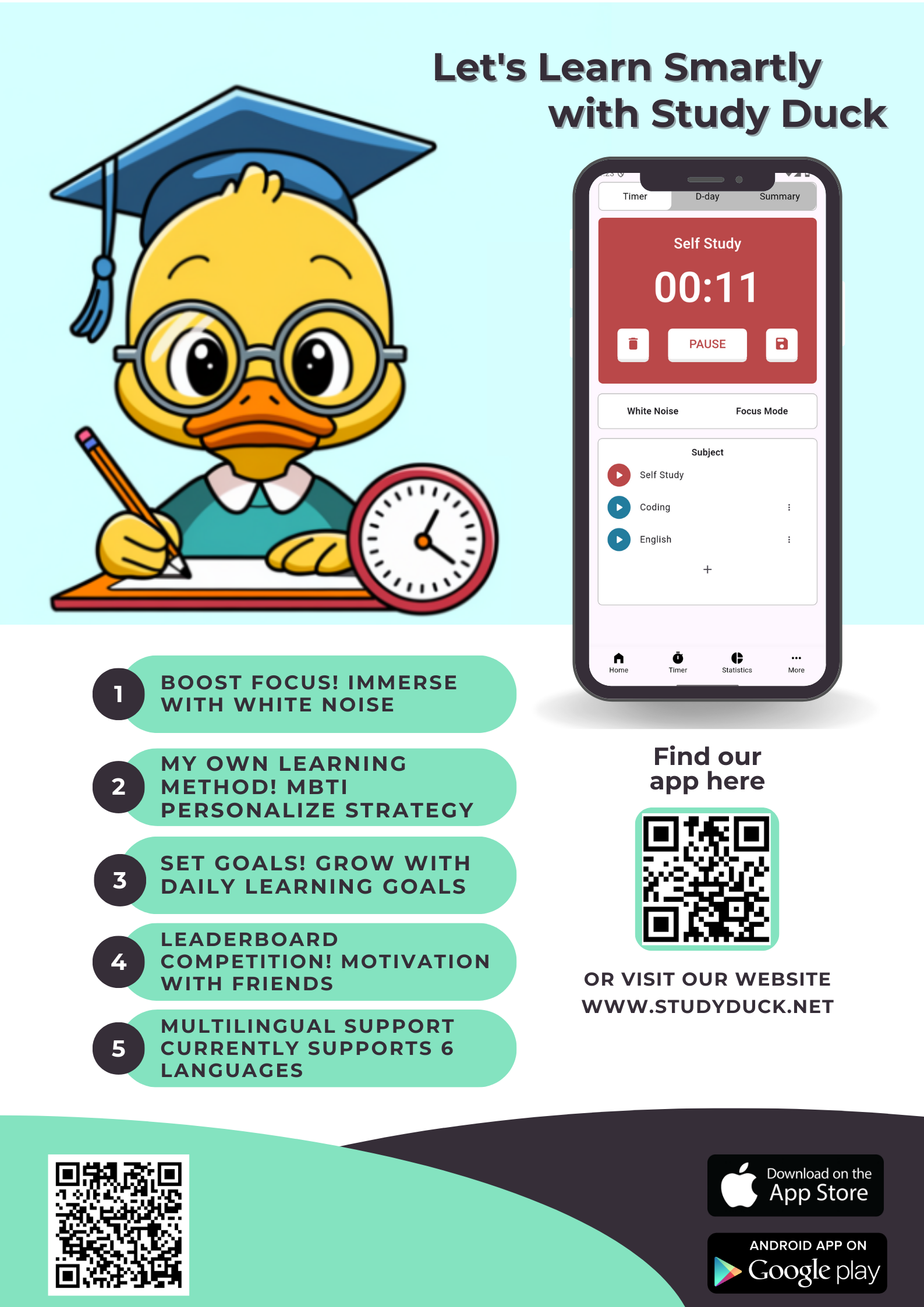
Hello, I’m StudyDuck, your learning consultant! Today, I’m excited to introduce Cross-Training Learning, a method that boosts learning efficiency and stimulates the brain from multiple angles.
Cross-Training Learning combines various study techniques to break the monotony of routine and enhance long-term learning outcomes.
In this post, we’ll explore the definition, benefits, and practical steps to implement Cross-Training Learning.
What is Cross-Training Learning?
Inspired by cross-training in sports, Cross-Training Learning involves alternating between different study methods or subjects.
For example, you might spend an hour solving math problems, then memorize English vocabulary, followed by watching a history documentary.
This approach stimulates various brain regions, reduces study fatigue, and improves the likelihood of long-term retention.
Why is Cross-Training Learning Effective?
- Enhanced Brain Flexibility: Focusing on a single subject can tire the brain and reduce efficiency. Cross-Training Learning keeps the brain agile by switching between different thinking patterns.
- Reduced Boredom: Repetitive studying can sap motivation. Diverse activities add fun and sustain engagement.
- Improved Information Connectivity: Discovering connections between subjects boosts creative thinking and problem-solving skills.
- Strengthened Long-Term Memory: Learning in varied contexts helps information stick in the brain more effectively.
How to Practice Cross-Training Learning
To apply Cross-Training Learning effectively, you need a structured plan. Here’s a step-by-step guide:
1. Set Learning Goals
Start by defining clear goals for the day or week. For example, “Solve math problems from Chapter 3, memorize 50 English words, and summarize five key historical events.”
2. Choose Diverse Learning Activities
Select different methods for each subject. Here are some examples:
- Math: Solve problems, then explain the concepts to a friend.
- English: Memorize vocabulary, then write a short essay using those words.
- History: Read a textbook, then watch a related YouTube video or draw a timeline.
3. Plan Time Allocation
Study in focused blocks of 25–50 minutes, then switch to a different subject or activity.
For instance, use the Pomodoro Technique (25 minutes of study, 5 minutes of rest) to alternate subjects while maintaining focus.
4. Optimize Study Order
Studying similar subjects back-to-back (e.g., math → physics) can make the brain feel repetitive.
Instead, arrange your schedule to alternate between analytical subjects (math), creative subjects (literature), and memory-based subjects (history) to stimulate the brain diversely.
5. Reflect and Adjust
At the end of the day or week, evaluate which combinations worked best.
For example, if video-based learning was more memorable, incorporate more visual resources into your plan the following week.
Real-Life Examples of Cross-Training Learning
Example 1: High School Student Minsoo
Minsoo used Cross-Training Learning to prepare for college entrance exams. His daily schedule looked like this:
- 09:00–09:50: Solve math problems
- 10:00–10:50: Read English passages and organize vocabulary
- 11:00–11:50: Listen to a Korean history lecture and take notes
- Afternoon: Review with short quizzes for each subject
Thanks to Cross-Training Learning, Minsoo maintained balance across subjects, avoided boredom, and saw steady improvement in his mock exam scores.
Example 2: Working Professional Jieun
Jieun wanted to improve her English conversation skills and learn data analysis. She dedicated two hours daily, structured as follows:
- 30 minutes: Practice conversation on an English app
- 30 minutes: Watch a data analysis lecture
- 30 minutes: Read a data analysis article in English
- 30 minutes: Practice simple Python coding
Through Cross-Training Learning, Jieun efficiently developed both skills, and reading English articles helped her connect the two subjects, boosting her motivation.
Tips for Success with Cross-Training Learning
- Avoid Overloading: Studying too many subjects at once can scatter focus. Limit yourself to 3–4 subjects or activities per day.
- Take Breaks: The brain needs rest to adapt to new stimuli. Include 5–10-minute breaks between study sessions.
- Align Activities with Goals: Ensure all activities tie back to your learning objectives. Adding unrelated tasks can waste time.
Conclusion
Cross-Training Learning is a powerful method to stimulate the brain from multiple angles, enhancing both efficiency and enjoyment in studying.
If you’re tired of monotonous study routines, give Cross-Training Learning a try today!
By combining diverse activities, you’ll discover your optimal learning style and make studying a rewarding experience.
Have questions or want to share your Cross-Training Learning experiences?
Leave a comment below. StudyDuck is cheering you on in your learning journey!
"Efficient learning tailored to your learning style, with Study Duck!"
By applying customized learning methods based on your MBTI, your learning effect doubles!
While you can learn quickly on your own, Study Duck helps you stay consistent and learn in the long term.
Stay focused with the study timer and maintain consistency by competing with others on the leaderboard.
Open a new chapter of learning with Study Duck now!
Study Duck - Smart Learning Assistant
Enhance your study efficiency with personalized MBTI learning strategies, focus mode, and white noise.
studyduck.net

'학습법' 카테고리의 다른 글
| ロールプレイング学習法:没入感と楽しさで学ぶ効果的な勉強法 (0) | 2025.04.25 |
|---|---|
| 롤플레잉 학습법: 몰입과 재미로 배우는 효과적인 공부법 (0) | 2025.04.25 |
| クロストレーニング学習法で学習効率を最大化:脳を多角的に刺激する勉強法 (0) | 2025.04.23 |
| 교차 학습법으로 학습 효율 극대화: 뇌를 다각도로 자극하는 공부법 (0) | 2025.04.23 |
| ケーススタディ学習法:実践的な問題解決能力を高める最適な学習戦略 (0) | 2025.04.22 |



